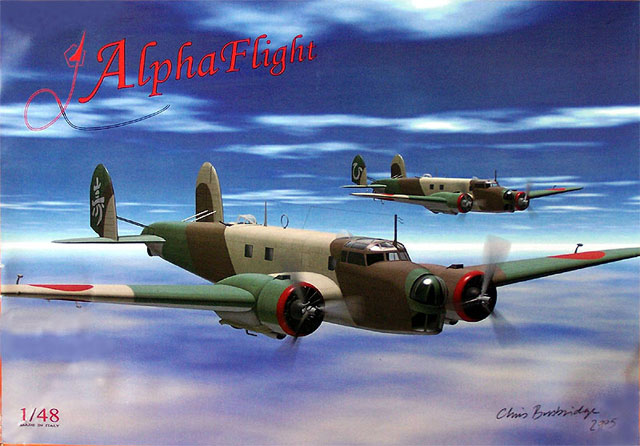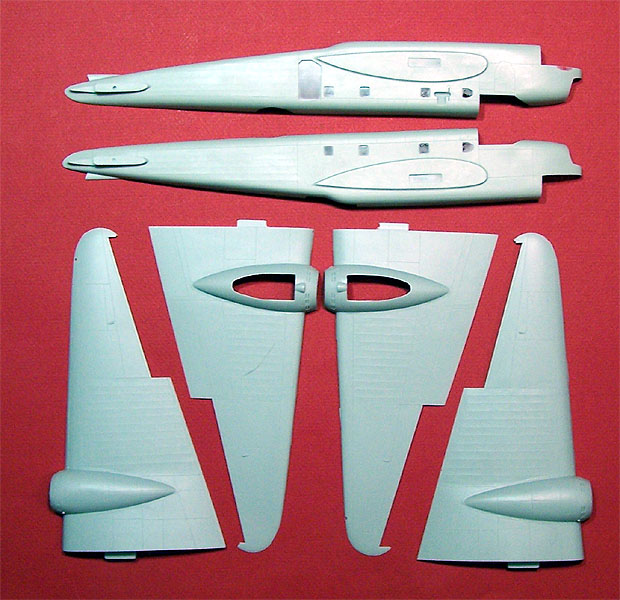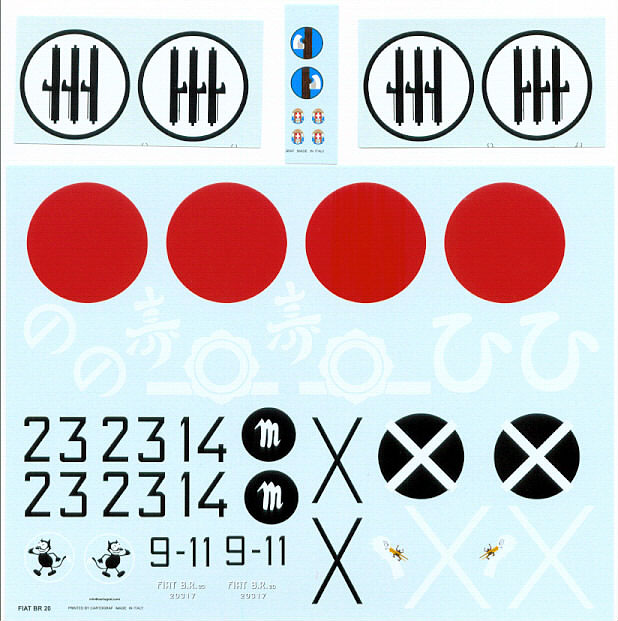|
Fiat BR.20

Alpha Flight, 1/48
scale
S
u m m a r y
|
| Catalogue Number: |
Kit #4806 - Fiat BR.20 |
| Scale: |
1/48 |
| Contents and Media: |
116 pieces in gray resin; 26 in
clear vacform; 7 white metal parts; 95 photo-etched parts; 3 printed
acetate panels; markings for 6 aircraft |
| Price: |
MSRP USD$189.95
available online from Pacific Coast Models |
| Review Type: |
FirstLook |
| Advantages: |
High quality castings; high level of detail;
useful inclusion of photo-etched parts; good decals
and instructions. |
| Disadvantages: |
Some air bubbles and light flash;
high price makes this for the discerning Italian or Japanese fan only! |
| Recommendation: |
Highly Recommended. |
Reviewed by Matt Swan

HyperScale is proudly supported by Squadron.com
This aircraft was first proposed in 1934 by Celestino
Rosatelli with the intent of creating a standardized bomber for the Italian
Air Force. Powered by a pair of Fiat A80 RC41 18 cylinder radial engines the
Br.20 took flight for the first time on February 10, 1936 at Torino Alitalia
and by November of 1937 20 aircraft had been delivered for operational use.
The type demonstrated very good handling characteristics and sturdy
construction but was to be quickly outclassed by new aircraft under
development in Germany, England and even in Italy. By 1940 the aircraft was
obsolete.
The Br.20 “Cicogna” (Stork) was partly skinned with light metal alloys and
partially with fabric. It did see action it the Spanish Civil war and in the
French campaign with Italy’s entry into the Second World War. Four basic
version of the Br.20 were manufactured with the initial run being simply
Br.20 followed by a modified version, Br.20M and a few Br.20 bis models and
about 82 for export to the Japanese as the Army Type 1 model 100 “Ruth” – a
short nosed version. The Japanese used these in the Manchurian War prior to
WW2. The only serious problem they had with it was the chronic lack of power
and the poor reliability of the Fiat engines. With a top speed of 158 MPH
and three light defensive guns it was not going to show good survivability
where air superiority was not maintained.
Even though an obsolete aircraft almost right from the start it was used by
Axis forces throughout the war. The production run was cut short when
Italian aircraft manufacturing decided to concentrate on the CANT Z.1018
bomber. Br.20s operated in Malta, Battle of Britain, Yugoslavia and the
Balkans. The Br.20M saw action against Russia, Allied forces in North Africa
and was even used briefly in the Battle of Britain but was withdrawn after
failing to achieve any real results.
By time production ceased approximately 594 aircraft of
all types had been manufactured.
This is an all resin kit - well almost all resin. She arrives in a
standard sized light duty cardboard box and within we have several bags of
goodies. First are the primary aircraft pieces. The wing panels and fuselage
halves look very much like what you would expect from an injection molded
kit other than they are resin, and good quality resin at that.

Click the
thumbnails below to view larger images:
The material is light gray and slightly flexible with a
nice smooth texture and no heavy mold release agent residues. While
examining the fuselage pieces thin flash is evident across the windows and
wing mounting holes but it is so thin that it virtually pops out with some
light pressure from the fingertip. Around the nose are of the left hand side
there are two very large air bubbles that must be filled before and
construction could begin. A few smaller air bubbles can be found here and
there but nothing very serious, better than found on most all resin kits.
There are also a few air bubbles found within the wing panels and again,
none of these are very serious in nature. Other than the light flash over
the windows there is no other flash evident on the parts. All panel lines
are fine and clean, fuselage fabric definition looks good, the inner sides
of the fuselage displays complete framing and no serious warpage is evident
in the large parts. Upon test fitting the fuselage all panel lines meet up
nicely.
Also included with this kit are two medium sized bags of resin detail
pieces. Here we have all the interior cockpit pieces, mass balancers,
nacelles, separate flight control surfaces and individual propeller blades
and hubs. Each engine includes eighteen separate cylinders to be mounted to
the crankcase/gear reduction box. Wheel wells have excellent interior detail
and the exhaust manifolds are like pieces of artwork. All the resin pieces
have a most definite feel of quality to them. In addition to the resin
pieces there is also a small fret of photo etched brass pieces. Here we have
more cockpit detailing items and engine detailing items. The dash harkens
back to the old MPM vacuform kits with a PE part that overlays an acetate
instrument sheet mounted on a plain backing plate. The kit includes two sets
of vacuformed clear pieces as well.
While the clear parts have good clarity and well
defined frame lines there are lots of little tiny dimples all through the
pieces from the vacuforming process.

On the plus side we do get two sets of these parts so
there is some room for error. As this is a resin kit it will have some
considerable mass once complete and to keep all this standing where it
belongs the landing gear are provided in white metal. The main struts,
retraction arms, rear strut and defensive guns are all done in white metal.
Taking a quick review of the package contents we have one hundred sixteen
resin pieces, thirteen clear parts (duplicated for twenty six), seven white
metal pieces, ninety five photo etched brass pieces and three acetate panels
for a total of two hundred forty seven pieces in the box.
Decals and Instructions
Instructions for this kit begin with a full sized A4
booklet with a brief historical background of the aircraft on the cover.
Following this is a complete parts map and twenty six exploded view
construction steps. Within the exploded views are a few interior painting
tips and some limited construction tips. For exterior painting and decal
placement we turn to two A3 sized full color spreads folded in the bottom of
the box. Here we have three-views of four Japanese aircraft, an Italian
aircraft and a Spanish Condor Legion

This kit actually comes with four sheets of decals; a
primary sheet and three small auxiliary sheets (you may click on the image
at right to view a larger picture). The primary sheet covers the four
Japanese aircraft and the Spanish bird. The three smaller sheets cover the
single Italian example shown in the instructions. The decals are by
Cartograf of Italy and look to be of exceptional quality. The print registry
is dead-on, color density looks very good and they seem to be properly thin
on the paper. The Italian set shows some real nice metallic gold in the
insignia as well.
A price tag of $189.95 can make most modelers think twice before reaching
for the wallet but one should first consider just how much cash is involved
in putting together a large modeling project that would include resin and PE
details and decal options for multiple aircraft. Starting with a middle of
the road kit and adding all the appropriate aftermarket items can easily
reach this same amount, if not more, quite quickly.
A unique aircraft and one not commonly found in this scale (other than the M
version also by Alpha Flight), this is most definitely something to acquire
for the discriminating Italian and Japanese aircraft collector. Other than a
few air bubbles the resin parts are all well cast, the photo etched pieces
will add a wonderful level of detail and the metal gear will ensure it
maintains its stance in your display. At this point in time there are no
aftermarket items for this kit and in truth it does not need any – it truly
is a complete model kit.
Highly Recommended.
Review sample courtesy
Pacific Coast Models.
Text and Images Copyright © 2006 by
Matt Swan
Page Created 16 March, 2006
Last updated 15 March, 2006
Back to HyperScale Main Page
Back to Reviews Page
|
Home | What's
New | Features
| Gallery |
Reviews | Reference
| Forum
| Search